 |
|
|
|
|
|
Make a mural of the Arctic.
All you need is a large sheet of mural paper about 3 feet by 6 feet and
paints or crayons. Click on the small pictures to download the full
sized artwork, or click on the link below each picture for the PDF version.
Then color, cut out the images and paste to the mural. Print as many
copies as you wish. Hints: To make the perspective of your mural put the smallest animals in front. |
|
|
|
|
|
An igloo is made of snow blocks sawed out of the snow. They are not placed layer upon layer, but in a continuous circular line like a snail. Much of the igloo is below the snow porch or entrance which can be blocked off with an animal hide. The Igloo is much bigger than it appears from the outside. |
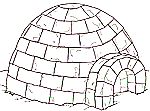 Igloo Click here for a sheet of small size Click here for reversed artwork Click here for PDF Format |
|
|
|
|
To color your polar bear shade with light gray around the edges of his shape so he appears to be rounded. Polar bears have a yellowish tint against the white snow so you can use a very pale yellow on his body. |
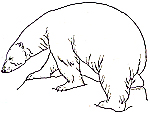 Polar Bear Click here for a sheet of small size Click here for reversed artwork Click here for PDF Format |
|
|
|
|
The largest male polar bear was
measured at eleven feet. Considered a marine mammal the polar bear is
at home in frigid Arctic ocean, kept warm by a layer of fat called blubber.
Polar bears swim long distances, but can be found hunting for seals along
the floe edge where the frozen se ice meet the open ocean. |
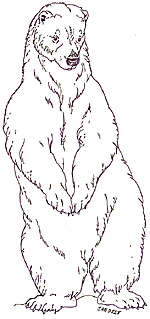 Papa Bear Click here for a sheet of small size Click here for reversed artwork Click here for PDF Format |
|
|
|
|
Papa Bear's parka goes straight across on the bottom and his hood is smaller and pointed. Color his parka grayish brown. His waterproof Kamiit boots) are dark gray black on the bottom. Men's and boys Kamiit have a vertical or up and down decoration. |
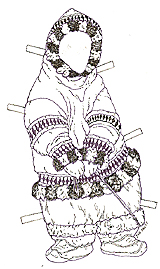 Papa Bears Clothes Click here for reversed artwork |
|
|
|
|
Polar bear's fur is not white, but clear. Each hair is hollow and funnels the sun's warmth into its black skin. Black absorbs light well. Of course, about the Arctic circle where polar bears live, the sun doesn't appear about the horizon in winter. |
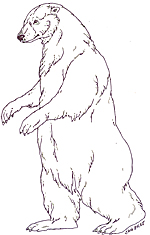 Mama Bear Click here for a sheet of small size Click here for reversed artwork Click here for PDF Format |
|
|
|
|
Mama bear's parka dips down in the front and back, making it recognizable as a woman's garment. Her large hood, called an amauti can be used like a backpack. Her boots are fancy, and would be worn at ceremonial dances and festivals. The are called Kamiit. |
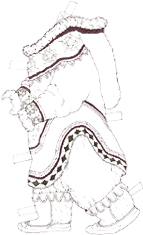 Mama Bear's Clothes Click here for reversed artwork |
|
|
|
|
Baby polar bears are the size of a guinea pig when they are born in the snow den the mother bear has made. Sometimes she has twins. In nature, the father bear is not involved in bringing up the cubs. |
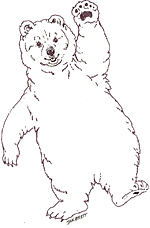 Baby Bear Click here for a sheet of small size Click here for reversed artwork Click here for PDF Format |
|
|
|
|
Baby Bear's parka dips down in the
front and back showing that it is worn by a woman or girl. Her parka
is a fancy one, worn on special occasions. The fur on the main part of
her parka is ground squirrel. Color it reddish brown with white spots. |
 Baby Bear's Clothes Click here for reversed artwork |
|
|
|
|
The flat ice pieces are called pans. They are part of the sea ice which is frozen ocean water. It is salty. The top is white, below is pale blue green. The surrounding ocean is deep blue green. |
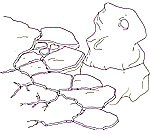 The Floe Edge (Print and connect several sections) Click here for a sheet of small size Click here for reversed artwork Click here for PDF Format |
|
|
|
|
The circular hole in the sea ice is a seal's breathing hole. You could place a seal on the ice near it. Sometimes a polar bear crouches beside the breathing hoe waiting for the seal to appear. The seal is a favorite food of the polar bear. |
 The Floe Edge 2nd Section (Print and connect several sections) Click here for a sheet of small size Click here for reversed artwork Click here for PDF Format |
|
|
|
|
The walrus, a male or bull color and brown gray. This is a very large mammal. It can be 12' long. Its tusks can grow to 3'. Its hair is sparse, although the male has long thick whiskers. It eats clams which it digs up with its tusks, but it also eats seabirds and seals. Walrus are dangerous and will attack boats. |
 Walrus Click here for a sheet of small size Click here for reversed artwork Click here for PDF Format |
|
|
|
|
The ringed seal is one of the
smaller seals, about 5'3 long. They carve deep breathing holes in the
ice with their teeth. |
 Ringed Seal Click here for a sheet of small size Click here for reversed artwork Click here for PDF Format |
|
|
|
|
The female hooded seal is the only seal with a distinctive blotched coat or pelage. The female is grown at 7'10". Her pup is nursed for only four days, and then it is on its own, the shortest period for any mammal. The female is creamy white with black blotches. |
Female Hooded Seal Click here for a sheet of small size Click here for reversed artwork Click here for PDF Format |
|
|
|
|
The harp seal male and female have
black heads and a black saddle shaped area on their backs. The harp
seal is smaller than the hooded seal. The seal grows to be six feet
three inches and the female five feet eleven inches. |
 Harp Seal with her Pup Click here for a sheet of small size Click here for reversed artwork Click here for PDF Format |
|
|
|
|
When a seal or walrus comes up onto the ice it is said to be hauled out. Both male and females have tusks. |
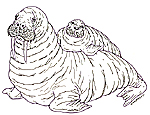 Walrus Mother with her Pups Click here for a sheet of small size Click here for reversed artwork Click here for PDF Format |
|
|
|
|
The male narwhal is 14' to 15' feet
long. The male has a long spiral tusk, the female does not. The
narwhal's enemies besides man are killer whales and polar bears. It
eats fish and shrimp but does not spear fish with its tusk. |
 Male Narwhal Click here for a sheet of small size Click here for reversed artwork Click here for PDF Format |
|
|
|
|
A woman's knife called a Ulu. |
Ulu |
|
|
|
|
A teakettle for brewing Labrador tea. |
Teakettle |
|
|
|
|
A frozen codfish |
Codfish |
|
|
|
|
The female is one foot smaller than the male, but is larger in the drawing. Her coloring is not finished, I am leaving it up to you. She has small black spots and speckles down the middle of her back. There are fewer spots on her sides. This view is from above, so her elegant flukes are seen. The calf is medium gray, with no spots. |
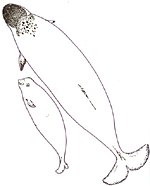 Narwhal and Calf Click here for a sheet of small size Click here for reversed artwork Click here for PDF Format |
|
|
|
|
Baffin island, the fifth largest island on earth borders Greenland, with Baffin Bay between, on the east. Tall tress do not survive because the ground is permanently frozen. Trees, such as the willow, have adapted by growing along the ground. Melt water from glaciers and midnight sun during June make the short growing season, about five weeks exceptionally beautiful. Deep fjord, channels that cut in from the shoreline, and high granite peaks are characteristic, as well as huge freshwater lakes. |
 Mountains Click here for a sheet of small size Click here for reversed artwork Click here for PDF Format Click here for reverse PDF Format |
|
|
|
|
Not far from the polar bear you will find the arctic fox. When a polar bear kills a seal it eats the blubber leaving the meat behind. When the bear is finished, the arctic fox moves in to eat his share. Arctic fox is a furrier more compact fox because it has to survive in extreme cold. Color the arctic fox by shading, since its coat is white. |
 Arctic Fox Click here for a sheet of small size Click here for reversed artwork Click here for PDF Format |
|
|
|
|
One of clothes for the arctic fox
is a parka with an amauti or hood. At the arts center in Pangnirtung,
a town in Baffin Island, some of the Inuit art pictured wild animals in
traditional Inuit clothes. |
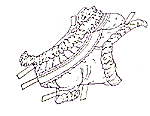 Clothes for the Arctic Fox Click here for reversed artwork |
|
|
|
|
In an Inuksuk, or traditional store marker, the rocks are shades of gray and brown but the lichens, which are slow growing plants that grow in cold environment are pale green (the round ones) and bright orange and brown (the spotty ones). An inuksuk points the way to an important place and is sometimes bult to look like a stone person! |
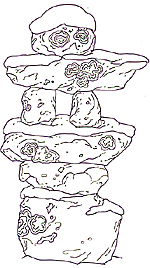 Inuksuk Stone Marker Click here for a sheet of small size Click here for PDF Format |
|
|
|
|
Aloo-ki, an Inuit girl is mushing or driving the dog team. She uses voice commands to tell the dogs to go left, gee, or right, haw. She has a big whip she can crack in the air if the dogs get distracted |
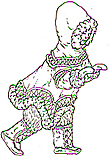 Aloo-ki Mushing Click here for a sheet of small size Click here for reversed artwork Click here for PDF Format |
|
|
|
|
A komatik or sled. The box in from caries supplies. Extra furs and seals from the hunt are covered over to make seats. Each dog is attached to a center piece in a fan shape by colored lines. Each one is a different color. The center piece is attached to the komatik on each side. |
 Komatik Sled Click here for a sheet of small size Click here for reversed artwork Click here for PDF Format |
|
|
|
|
The Greenland Inuit dog is of the husky dog type, a working breed. It is unusual because it has remained pure for thousands of years. It is as hardy as an Arctic wolf, but is playful and gentle when handled properly. |
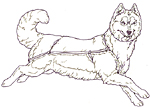 Greenland Inuit Dog Facing Click here for a sheet of small size Click here for reversed artwork Click here for PDF Format |
|
|
|
|
Today's sled dogs have been replaced by snow machine for pulling a komatik or sled. But nothing can replace the canny, resourceful sled dog for safety on the ice. |
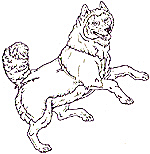 Sled Dog Jumping Click here for a sheet of small size Click here for reversed artwork Click here for PDF Format |
|
|
|
|
On Baffin Island, the team of Greenland Inuit sled dogs was owned and trained by Arctic expedition leader, Mattie McNair. Louis-Philip Pothier was the musher for our trip. He drove them and helped with the dog's training and conditioning. |
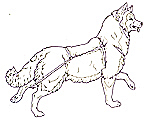 Sled Dog Running Click here for a sheet of small size Click here for reversed artwork Click here for PDF Format |
|
|
|
|
In treeless areas sled dogs are attached to the Komatik or sled by a fan hitch. Each don't pulling line is a different color. The lead dog is first and he or she obeys the voice commands of the musher or driver. |
 Sled Dog Running Head Down Click here for a sheet of small size Click here for reversed artwork Click here for PDF Format |